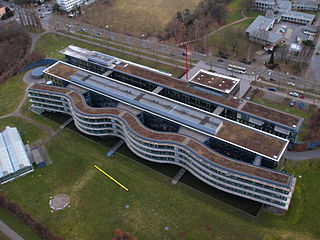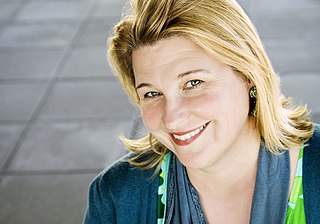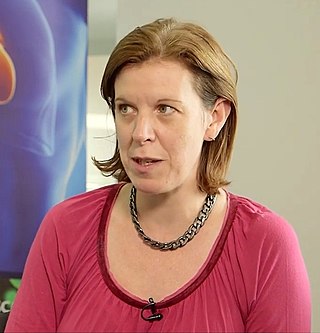Computational neuroscience is a branch of neuroscience which employs mathematics, computer science, theoretical analysis and abstractions of the brain to understand the principles that govern the development, structure, physiology and cognitive abilities of the nervous system.

Max Planck Institute for Neurobiology of Behavior – caesar in Bonn is a non-university research institute of the Max Planck Society. It was founded on 1 January 2022. The institute had been associated with the Max Planck Society since 2006, known as the Center of Advanced European Studies and Research (caesar) and has had its focus on neurosciences since this time.

Peter Dayan is a British neuroscientist and computer scientist who is director at the Max Planck Institute for Biological Cybernetics in Tübingen, Germany, along with Ivan De Araujo. He is co-author of Theoretical Neuroscience, an influential textbook on computational neuroscience. He is known for applying Bayesian methods from machine learning and artificial intelligence to understand neural function and is particularly recognized for relating neurotransmitter levels to prediction errors and Bayesian uncertainties. He has pioneered the field of reinforcement learning (RL) where he helped develop the Q-learning algorithm, and made contributions to unsupervised learning, including the wake-sleep algorithm for neural networks and the Helmholtz machine.

Henry John Markram is a South African-born Israeli neuroscientist, professor at the École Polytechnique Fédérale de Lausanne (EPFL) in Switzerland and director of the Blue Brain Project and founder of the Human Brain Project.

Alexander "Axel" Borst is a German neurobiologist. He is director at the Max Planck Institute for Biological Intelligence and head of the department Circuits – Computation – Models.
Nikos K. Logothetis is a Greek biologist and neuroscientist. Logothetis studies visual perception and object recognition; he is well-known for his work demonstrating that BOLD fMRI data is related to neuronal activity. Logothetis directed the department of Physiology of Cognitive Processes at the Max Planck Institute for Biological Cybernetics in Tübingen from 1996 to 2020. He will co-direct the International Center for Primate Brain Research in Shanghai beginning in late 2020 or early 2021.

Angela Friederici is a director at the Max Planck Institute for Human Cognitive and Brain Sciences in Leipzig, Germany, and is an internationally recognized expert in neuropsychology and linguistics. She is the author of over 400 academic articles and book chapters, and has edited 15 books on linguistics, neuroscience, language and psychology.

Tania Singer is a German psychologist and social neuroscientist and the scientific director of the Max Planck Society's Social Neuroscience Lab in Berlin, Germany. Between 2007 and 2010, she became the inaugural chair of social neuroscience and neuroeconomics at the University of Zurich and was the co-director of the Laboratory for Social and Neural Systems Research in Zurich. Her research focuses on the developmental, neuronal, and hormonal mechanisms underlying human social behavior and social emotions such as compassion and empathy. She is founder and principal investigator of the ReSource project, one of the largest longitudinal studies on the effects of mental training on brain plasticity as well as mental and physical health, co-funded by the European Research Council. She also collaborates with the macro-economist Dennis Snower on research on caring economics. Singer's Caring Economics: Conversations on Altruism and Compassion, Between Scientists, Economists, and the Dalai Lama was published in 2015. She is the daughter of the neuroscientist Wolf Singer.
Andreas Karl Engel is a German neuroscientist. He is the director of the Department of Neurophysiology and Pathophysiology at the University Medical Center Hamburg-Eppendorf (UKE).
In neuroscience, predictive coding is a theory of brain function which postulates that the brain is constantly generating and updating a "mental model" of the environment. According to the theory, such a mental model is used to predict input signals from the senses that are then compared with the actual input signals from those senses. Predictive coding is member of a wider set of theories that follow the Bayesian brain hypothesis.

Oriol Mitjà i Villar is a Catalan-born Spanish researcher and consultant physician in internal medicine and infectious diseases with expertise in poverty-related tropical diseases. He has conducted research at the Lihir Medical Centre in Papua New Guinea since 2010 on new diagnostic and therapeutic tools to eradicate yaws. He was awarded the Princess of Girona Award in the scientific research category. Currently at the Germans Trias i Pujol Research Institute, Mitjà is conducting research on SARS-CoV-2 coronavirus disease (COVID-19) and strategies to control the infection at a community level.

Li Zhaoping, born in Shanghai, China, is a neuroscientist at the University of Tübingen in Germany. She is the only woman to win the first place in CUSPEA, a 1980s annual national physics admission examination in China, during CUSPEA's 10-year history (1979–1989). She proposed V1 Saliency Hypothesis (V1SH), and is the author of Understanding vision: theory, models, and data published by Oxford University Press.

Michael Joseph Ryan is an Irish epidemiologist and former trauma surgeon, specialising in infectious disease and public health. He is executive director of the World Health Organization's Health Emergencies Programme, leading the team responsible for the international containment and treatment of COVID-19. Ryan has held leadership positions and has worked on various outbreak response teams in the field to eradicate the spread of diseases including bacillary dysentery, cholera, Crimean–Congo hemorrhagic fever, Ebola, Marburg virus disease, measles, meningitis, relapsing fever, Rift Valley fever, SARS, and Shigellosis.

Laura Busse is a German neuroscientist and professor of Systemic Neuroscience within the Division of Neurobiology at the Ludwig Maximilian University of Munich. Busse's lab studies context-dependent visual processing in mouse models by performing large scale in vivo electrophysiological recordings in the thalamic and cortical circuits of awake and behaving mice.

Kanaka Rajan is a computational neuroscientist in the Department of Neurobiology at Harvard Medical School and founding faculty in the Kempner Institute for the Study of Natural and Artificial Intelligence at Harvard University. Rajan trained in engineering, biophysics, and neuroscience, and has pioneered novel methods and models to understand how the brain processes sensory information. Her research seeks to understand how important cognitive functions — such as learning, remembering, and deciding — emerge from the cooperative activity of multi-scale neural processes, and how those processes are affected by various neuropsychiatric disease states. The resulting integrative theories about the brain bridge neurobiology and artificial intelligence.

Wulfram Gerstner is a German and Swiss computational neuroscientist. His research focuses on neural spiking patterns in neural networks, and their connection to learning, spatial representation and navigation. Since 2006 Gerstner has been a full professor of Computer Science and Life Sciences at École Polytechnique Fédérale de Lausanne (EPFL), where he also serves as a Director of the Laboratory of Computational Neuroscience.
Vittoria Colizza is an Italian scientist, research director at INSERM and a specialist in mathematical modeling of infectious disease and computational epidemiology. In particular, she has carried out research on the modeling of seasonal and pandemic flu, Ebola and the COVID-19 pandemic.
Tatjana Tchumatchenko is a physicist in the field of theoretical neuroscience. She is an independent Max Planck Group Leader and, since November 2020, professor for Computational Neuroscience of Behavior at the Faculty of Medicine of the Rheinische Friedrich-Wilhelms-Universität Bonn (Germany). In her research she investigates how neural networks compute and how particular activity patterns emerge from synaptic and neuronal features.
Jonas Obleser is a German psychologist and neuroscientist.

Susanna Jane Dunachie is a British microbiologist who is Professor of Infectious Diseases at the University of Oxford. Her work considers microbiology and immunology to better understand bacterial infection and accelerate the development of vaccines. She has focused on melioidosis, scrub typhus and tuberculosis. During the COVID-19 pandemic, she studied T cell immunity to severe acute respiratory syndrome coronavirus 2.













